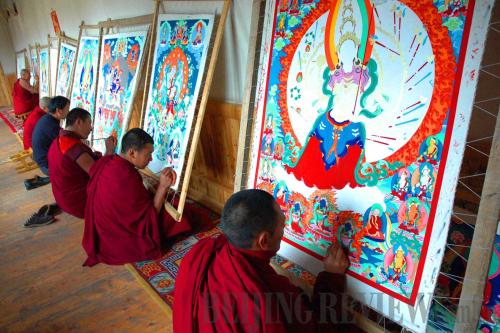|
 |
|
DRAWING THANGKA: Painters are working on their Thangka works in an exhibition center in Xiehe County of Gannan Tibetan Autonomous Prefecture, Gansu Province (WANG YANMING) |
China's contemporary culture and the protection of its diverse cultural heritage have become some of the most talked about issues today. Cultural prosperity was put forward as an important objective of the Central Government's national development strategy last year. However, the industrialization and commercialization of China's culture have been both criticized and celebrated. Many scholars believe industrialization and enormous government investment may not be the best means to protect intangible cultural heritage (ICH).
The Ninth Forum on International Cultural Industries was held by Peking University in Beijing between January 7 and 8. Over 400 guests, including scholars, experts, officials and entrepreneurs, discussed the state and future of cultural issues during the two-day meeting. The protection and revival of intangible cultural heritage were also a heated topic of discussion.
While it is a driving force of cultural diversity, living heritage is very fragile. But it has received international recognition in recent years. Protecting distinct traditions, art and craft forms has become one of the priorities of international cooperation thanks to UNESCO's leading role in the adoption of the Convention for the Safeguarding of Intangible Cultural Heritage.
China has a continuous civilization of over 5,000 years, and is therefore endowed with a rich cultural heritage. By the end of 2011, UNESCO had inscribed 29 Chinese ICH items on its Representative List of the Intangible Cultural Heritage of Humanity, and seven on the List of Intangible Cultural Heritage in Need of Urgent Safeguarding. China is home to more UNESCO certified ICH traditions than any other nation in the world.
Despite this recognition, many of China's folk traditions and cultural rites are on the verge of extinction due to lifestyle changes and technological advances. Still, the country has made enormous efforts to save this fast vanishing heritage.
"During the past five years, China has made a lot of efforts to protect its living heritage," said Ma Shengde, Deputy Director of the Department of Intangible Cultural Heritage under the Ministry of Culture, in a speech at the forum.
To protect the country's living heritage, the State Council, China's cabinet, also released a national list for it. Initiated in 2006, the list now comprises 1,219 items. According to a nationwide survey, there are nearly 870,000 living heritage items in China. The government has also certified 1,488 masters—craftsmen, jewelers, carpenters, and cooks, who have inherited and will pass on distinct traditions.
As of 2011, the special fund for protecting intangible cultural heritage stood at 1.5 billion yuan ($237 million). Crucially, China's first law protecting intangible cultural heritage was passed by the National People's Congress on February 25, 2011, and went into effect on June 1, 2011.
"All these measures are echoed strongly and widely in the country," Ma said.
In addition to policies and laws, China has also incorporated the notion of "protection through production" into its preservation philosophy.
"Productivity and market appeal are common features of a lot of intangible cultural heritage," said Ma. "The approach has proved very helpful in protecting heritage, particularly traditional crafts."
Nevertheless, "protection through production" has been criticized for commercializing traditions and damaging their authenticity.
Some see this commercialization as effectively eroding cultural heritage. For example, the fact that fine arts works are manufactured in large quantities in factories instead of being handmade in workshops is threatening the sustainable inheritance of traditional craftsmanship.
"These cultural items are invaluable. We can't produce them limitlessly like mining coal resources," said Ma. "Cheap copies of traditional crafts dominate the market, affecting the existence of authentic artworks. The commercial production of Thangka, traditional Buddhist scrolls painted in Tibetan areas, is one example where mass production is eroding the livelihood of real artisans."
Before drawing an authentic Thangka, painters must hold a worship and cleansing ceremony to express their respect to the Buddha and their ancestors, which is the core value of this Tibetan cultural heritage. Machine printed Thangka loses this cultural connotation and spirit.
"Ancient traditions of fine arts will be destroyed by over-commercialization if we don't stop the excessive industrialization and commercialization of living heritage," said Ma.
| 